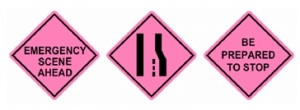Difference between revisions of "Traffic Cones"
From Standard Operating Guidelines
Mfrdmanager (talk | contribs) |
Mfrdmanager (talk | contribs) (→PURPOSE:) |
||
| (12 intermediate revisions by the same user not shown) | |||
| Line 1: | Line 1: | ||
==Section 2 - EMERGENCY OPERATIONS== | ==Section 2 - EMERGENCY OPERATIONS== | ||
| − | ===210. | + | ===210.11 Traffic Cones=== |
===PURPOSE:=== | ===PURPOSE:=== | ||
* Traffic cones should be inventoried every morning during morning vehicle checkout. | * Traffic cones should be inventoried every morning during morning vehicle checkout. | ||
* While on emergency calls traffic cones should always be considered for further crew safety while working on roads and highways. | * While on emergency calls traffic cones should always be considered for further crew safety while working on roads and highways. | ||
| − | * When placing cones utilize the tapering technique to gradually close lanes of traffic and extend the cones past the | + | * When placing cones utilize the tapering technique to gradually close lanes of traffic and extend the cones past the fend-off unit and crews working in the road or highway. The term tapering refers to merging one or several lanes of traffic into fewer lanes to provide scene safety. |
* Cones should be placed 15-30 feet apart based on the distance of lane closure. | * Cones should be placed 15-30 feet apart based on the distance of lane closure. | ||
* Always place traffic cones while facing the oncoming traffic for safety. | * Always place traffic cones while facing the oncoming traffic for safety. | ||
| − | * Traffic cones can be found on all front line apparatus. Remember many law enforcement vehicles carry traffic cones if | + | * Traffic cones can be found on all front line apparatus. Remember many law enforcement vehicles carry traffic cones if additional cones are needed. |
* Traffic cone visibility can be increased with the use of LZ strobes if needed per OIC discretion. | * Traffic cone visibility can be increased with the use of LZ strobes if needed per OIC discretion. | ||
* Traffic cones can also be utilized to completely block lanes of traffic if needed.<BR> | * Traffic cones can also be utilized to completely block lanes of traffic if needed.<BR> | ||
| Line 14: | Line 14: | ||
Below is an example of utilizing the tapering technique. | Below is an example of utilizing the tapering technique. | ||
| − | [[File:cones.jpg|left|600px|]] | + | [[File:cones.jpg|left|600px|]]<br> |
| + | |||
| + | |||
| + | |||
| + | |||
| + | |||
| + | |||
| + | |||
| + | |||
| + | |||
| + | |||
| + | |||
| + | |||
| + | |||
| + | |||
| + | |||
| + | |||
| + | |||
| + | |||
| + | |||
| + | |||
| + | |||
| + | |||
| + | |||
| + | |||
| + | |||
| + | |||
| + | |||
| + | |||
| + | |||
| + | |||
| + | |||
| + | |||
| + | |||
| + | |||
| + | |||
| + | |||
| + | |||
| + | |||
| + | |||
| + | An additional traffic safety device that may be utilized is the “Emergency Scene Ahead” sign located on Battalion 45. This sign can provide for an advanced warning to motorist on high-speed traffic roadways. This sign should be placed well in advance of the emergency scene. | ||
| + | |||
| + | [[File:BCsigns.jpg|left|300px|]] | ||
[[Category:Fire Operations - Fire Suppression]] | [[Category:Fire Operations - Fire Suppression]] | ||
Latest revision as of 05:20, 28 October 2017
Section 2 - EMERGENCY OPERATIONS
210.11 Traffic Cones
PURPOSE:
- Traffic cones should be inventoried every morning during morning vehicle checkout.
- While on emergency calls traffic cones should always be considered for further crew safety while working on roads and highways.
- When placing cones utilize the tapering technique to gradually close lanes of traffic and extend the cones past the fend-off unit and crews working in the road or highway. The term tapering refers to merging one or several lanes of traffic into fewer lanes to provide scene safety.
- Cones should be placed 15-30 feet apart based on the distance of lane closure.
- Always place traffic cones while facing the oncoming traffic for safety.
- Traffic cones can be found on all front line apparatus. Remember many law enforcement vehicles carry traffic cones if additional cones are needed.
- Traffic cone visibility can be increased with the use of LZ strobes if needed per OIC discretion.
- Traffic cones can also be utilized to completely block lanes of traffic if needed.
Below is an example of utilizing the tapering technique.
An additional traffic safety device that may be utilized is the “Emergency Scene Ahead” sign located on Battalion 45. This sign can provide for an advanced warning to motorist on high-speed traffic roadways. This sign should be placed well in advance of the emergency scene.

